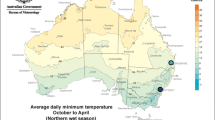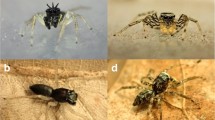Abstract
Many animals exhibit elaborate traits and conspicuous behaviors. Sexual or social selection are often drivers of extreme trait elaboration and signalling, but conspicuous traits may also serve non-social functions. The matador bug, Anisoscelis alipes (Hemiptera: Coreidae), has large, brightly colored tibial expansions on its hind legs which are used to perform a stereotypic “waving” behavior, the function of which is unknown. If this phenotype functions primarily as a sexually selected aggressive signal, we predicted sexual dimorphism both in morphology and behavior, as well as positive size allometry. Alternatively, if these traits function as non-sexual social signals, both male and females may perform waving behavior, and the frequency or rate of flag-waving should increase with proximity to conspecifics. Against some of our predictions, we found both males and females exhibited hind leg expansions which scaled isometrically with body size. We recorded 745 leg waves among 12 individuals and found no difference in the overall number of waves or the rate of waving between males and females. Further, the sex of individuals in the social environment did not predict the number of waves or rate of flag-waving. Sexual selection is often reported to be the main driver of many highly conspicuous traits, but our investigation of morphology, behavior, and natural history reveals little evidence for social or sexual selection as the primary driver of these conspicuous signals. We suggest future studies investigate a potential anti-predator function to explain the evolution of colorful and expanded tibial flags in other flag-legged bugs.




Similar content being viewed by others
Data availability
Data is in the DRYAD repository. https://doi.org/10.5061/dryad.rbnzs7hc7
References
Alarcon M, Cazorla D (2020) Descripción de los estadios inmaduros y ciclo de vida de Anisoscelis (bitta) hymenipherus Westwood, 1840 (Heteroptera: Coreidae: Coreinae: Anisoscelini). Rev Nicaragüense Entomol 218:2–67
Aldrich J (1988) Chemical ecology of the Heteroptera. Annu Rev Entomol 33:211–238
Aldrich JR, Blum MS (1978) Aposematic aggregation of a bug (Hemiptera: Coreidae): The defensive display and formation of aggregations. Biotropica 10:58
Bateman PW, Fleming PA, Rolek B (2014) Bite me: Blue tails as a “risky-decoy” defense tactic for lizards. Curr Zool 60:333–337
Bates D, Mächler M, Bolker BM, Walker SC (2015) Fitting linear mixed-effect models using lme4. J Stat Softw 67:1–48
Bertram SM, Orozco SX, Bellani R (2004) Temporal shifts in conspicuousness: Mate attraction displays of the Texas field cricket, Gryllus texensis. Ethology 110:963–975
Clutton-Brock TH (2007) Sexual selection in males and females. Science 318:1882–1885
Cott H (1940) Animal coloration and natural selection. Nature 146:144–145
Cumming RT, Le Tirant S (2021) Drawing the excalibur bug from the stone: Adding credibility to the double-edged sword hypothesis of coreid evolution (Hemiptera, Coreidae). ZooKeys 1043:117–131
Darwin C (1871) The descent of man, and selection in relation to sex. Murray, London
Dehn MM (1990) Vigilance for predators; detection and dilution effects. Behav Ecol Sociobiol 26:337–342
Eberhard WG (1998) Sexual behavior of Acanthocephala declivis guatemalana (Hemiptera: Coreidae) and the allometric scaling of their modified hind legs. Behavior 91:863–871
Eberhard WG, Rodríguez RL, Huber BA et al (2018) Sexual selection and static allometry: The importance of function. Q Rev Biol 93:207–250
Edmunds M (1974) Defence in animals: a survey of anti-predator defences. Longman Publishing Group, London
Emberts Z, St. Mary CM, Howard CC et al (2020) The evolution of autotomy in leaf-footed bugs. Evolution 74:897–910
Emberts Z, St Mary CM, Miller CW (2016) Coreidae (Insecta: Hemiptera) limb loss and autotomy. Ann Entomol Soc Am 109:1–6
Falk JJ, Rubenstein DR, Rico-Guevara A, Webster MS (2022) Intersexual social dominance mimicry drives female hummingbird polymorphism. Proc R Soc B Biol Sci 289:20220332
Falk JJ, Webster MS, Rubenstein DR (2021) Male-like ornamentation in female hummingbirds results from social harassment rather than sexual selection. Curr Biol 31:1–7
Glazier DS (2013) Log-transformation is useful for examining proportional relationships in allometric scaling. J Theor Biol 334:200–203
Hebets EA, Papaj DR (2005) Complex signal function: Developing a framework of testable hypotheses. Behav Ecol Sociobiol 57:197–214
Houle D, Pelabon C, Wagner GP, Hansen TF (2011) Measurement and meaning in biology. Quaterly Rev Biol 86:3–34
Khan MK, Herberstein ME (2020) Ontogenetic colour change signals sexual maturity in a non-territorial damselfly. Ethology 126:51–58
Lande R (1980) Sexual dimorphism, sexual selection and adaptation in polygenic characters. Evolution 34:292–305
López-Palafox TG, Luis-MartÍnez A, Cordero C (2015) The movement of “false antennae” in butterflies with “false head” wing patterns. Curr Zool 61:758–764
Lyon BE, Montgomerie R (2012) Sexual selection is a form of social selection. Philos Trans R Soc B Biol Sci 367:2266–2273
Miller CW, Emlen DJ (2010) Across- and within-population differences in the size and scaling relationship of a sexually selected trait in Leptoscelis tricolor (Hemiptera: Coreidae). Ann Entomol Soc Am 103:209–215
Mitchell PL (1980) Combat and territorial defense of Acanthocephala femorata (Hemiptera: Coreidae). Ann Entomol Soc Am 73:404–408
Miyatake T (1997) Functional morphology of the hind legs as weapons for male contests in Leptoglossus australis (Heteroptera: Coreidae). J Insect Behav 10:727–735
Miyatake T (2002) Multi-male mating aggregation in Notobitus meleagris (Hemiptera: Coreidae). Ecol Popul Biol 95:340–344
Murphy TG (2006) Predator-elicited visual signal: Why the turquoise-browed motmot wag-displays its racketed tail. Behav Ecol 17:547–553
Murphy TG (2007) Racketed tail of the male and female turquoise-browed motmot: Male but not female tail length correlates with pairing success, performance, and reproductive success. Behav Ecol Sociobiol 61:911–918
Okada K, Suzaki Y, Okada Y, Miyatake T (2011) Male aggressive behavior and exaggerated hindlegs of the bean Bug Riptortus pedestris. Zoolog Sci 28:659–663
Okie JG, Boyer AG, Brown JH et al (2013) Effects of allometry, productivity and lifestyle on rates and limits of body size evolution. Proc R Soc B Biol Sci 280:20131007
Pekár S, Petráková L, Bulbert MW et al (2017) The golden mimicry complex uses a wide spectrum of defence to deter a community of predators. eLife 6:1–25
Pennell TM, Morrow EH (2013) Two sexes, one genome: The evolutionary dynamics of intralocus sexual conflict. Ecol Evol 3:1819–1834
Perez DM, Backwell PRY (2020) The functions of multiple visual signals in a fiddler crab. Ethology 126:455–462
Poulton E (1890) The colours of animals. Kegan Paul, Trench, Trübner & Co Ltd, London
Prudic KL, Noge K, Becerra JX (2008) Adults and nymphs do not smell the same: The different defensive compounds of the giant mesquite bug (Thasus neocalifornicus: Coreidae). J Chem Ecol 34:734–741
R Core Team (2019) R: A language and environment for statistical computing. Vienna, Austria. https://www.r-project.org/
Rodrigues D, Duarte LS, Moreira GRP (2007) Performance consequences of food mixing in two passion vine leaf-footed bugs, Holymenia clavigera (Herbst, 1784) and Anisoscelis foliacea marginella (Dallas, 1852) (Hemiptera; Coreidae). Braz J Biol 67:91–99
Rojas B, Burdfield-Steel E, De Pasqual C et al (2018) Multimodal aposematic signals and their emerging role in mate attraction. Front Ecol Evol 6:1–24
Rößler DC, Lötters S, Mappes J et al (2019) Sole coloration as an unusual aposematic signal in a Neotropical toad. Sci Rep 9:1–11
Rubin JJ, Hamilton CA, McClure CJW et al (2018) The evolution of anti-bat sensory illusions in moths. Sci Adv 4:1–10
Ruxton GD, Allen WL, Sherratt TN, Speed MP (2018) Avoiding attack, 2nd edn. Oxford University Press, Oxford
Shuker DM, Kvarnemo C (2021) The definition of sexual selection. Behav Ecol 32:781–794
Somjee U (2021) Positive allometry of sexually selected traits: Do energetic costs play a important role? BioEssays 43:1–13
Somjee U, Allen PE, Miller CW (2015) Different environments lead to a reversal in the expression of weapons and testes in the heliconia bug, Leptoscelis tricolor (Hemiptera: Coreidae). Biol J Linn Soc 115:802–809
Somjee U, Arthur Woods H, Duell M, Miller CW (2018) The hidden cost of sexually selected traits: The metabolic expense of maintaining a sexually selected weapon. Proc R Soc B Biol Sci 285:1891
Somjee U, Miller CW, Tatarnic NJ, Simmons LW (2017) Experimental manipulation reveals a trade-off between weapons and testes. J Evol Biol 31:57–65
Somjee U, Powell E, Hickey AJ, Painting CJ (2021) Exaggerated sexually selected weapons maintained with disproportionately low metabolic costs in a single species with extreme size variation. Funct Ecol 35:2282–2293
Sourakov A (2013) Two heads are better than one: false head allows Calycopis cecrops ( Lycaenidae ) to escape predation by a Jumping Spider, Phidippus pulcherrimus(Salticidae). J Nat Hist 47:37–41
South SH, Arnqvist G (2009) Morphological variation of an ornament expressed in both sexes of the mosquito Sabethes cyaneus. Evol Ecol Res 11:1–21
South SH, Arnqvist G (2008) Evidence of monandry in a mosquito (Sabethes cyaneus) with elaborate ornaments in both sexes. J Insect Behav 21:451–459
Taylor LA, Maier EB, Byrne KJ et al (2014) Colour use by tiny predators : jumping spiders show colour biases during foraging. Anim Behav 90:149–157
Tobias JA, Montgomerie R, Lyon BE (2012) The evolution of female ornaments and weaponry: Social selection, sexual selection and ecological competition. Philos Trans R Soc B Biol Sci 367:2274–2293
Trillo PA, Bernal XE, Caldwell MS et al (2016) Collateral damage or a shadow of safety? The effects of signalling heterospecific neighbours on the risks of parasitism and predation. Proc R Soc B Biol Sci 283:20160343
Vidal-García M, O’Hanlon JC, Svenson GJ, Umbers KDL (2020) The evolution of startle displays: a case study in praying mantises. Proc R Soc B Biol Sci 287:20201016
Watson CM, Roelke CE, Pasichnyk PN, Cox CL (2012) The fitness consequences of the autotomous blue tail in lizards : an empirical test of predator response using clay models. Zoology 115:339–344
Webster MS, Ligon RA, Leighton GM (2018) Social costs are an underappreciated force for honest signalling in animal aggregations. Anim Behav 143:167–176
West-Eberhard MJ (1983) Sexual selection, social competition and speciation. Q Rev Biol 58:155–183
White TE, Umbers KDL (2021) Meta-analytic evidence for quantitative honesty in aposematic signals. Proc R Soc B Biol Sci 288:20210679
Wrona FJ, Dixon RWJ (1991) Group size and predation risk: a field analysis of encounter and dilution effects. Am Nat 137:186–201
Yang Y, Richards-Zawacki CL, Devar A, Dugas MB (2016) Poison frog color morphs express assortative mate preferences in allopatry but not sympatry. Evolution 70:2778–2788
Acknowledgements
We thank Lovisa Dück for invaluable assistance in the field and collecting insects. Sabrina Amador and Annette Aiello provided insightful feedback and support throughout this project. We thank Mario Santamaria for access to his farm and maracuyà plants. Gregg Cohen, Rachel Page, William Wcislo, Katherine Sinacore, Adriana Tapia, Benita C. Laird-Hopkins, Harlan Gough and Dumas Galvez for assistance finding and collecting insects. We would also like to acknowledge the support of MiAmbiente (Ministerio de Ambiente, Panama) for collecting and research permits (permit #SC/A-33-19).
Funding
This project was supported by the Smithsonian Tropical Research Institute (STRI) Earl S. Tupper post-doctoral fellowship to US. A STRI short-term fellowship to CL. Association for the Study of Animal Behaviour grant to GG.
Author information
Authors and Affiliations
Contributions
CL, US, GG, and MJ designed the study. CL & CR collected the data. JF, US, and CL analysed the data. CL and US wrote the paper. US, CL, JF, DR, GG, JR provided critical feedback on writing and analysis.
Corresponding author
Ethics declarations
Ethics Approval and Consent to Participate
The data was collected with approval from MiAmbiente research permit to Ummat Somjee (SC/A-33–19). The focal species in this study is not under protection. No approval from an ethics committee was required for this species.
Competing Interests
We have no competing interests to declare.
Additional information
Publisher's Note
Springer Nature remains neutral with regard to jurisdictional claims in published maps and institutional affiliations.
Supplementary Information
Below is the link to the electronic supplementary material.
Supplementary file1 (MOV 17622 KB)
Supplementary file2 (MP4 6572 KB)
Rights and permissions
Springer Nature or its licensor (e.g. a society or other partner) holds exclusive rights to this article under a publishing agreement with the author(s) or other rightsholder(s); author self-archiving of the accepted manuscript version of this article is solely governed by the terms of such publishing agreement and applicable law.
About this article
Cite this article
Longbottom, C., Falk, J.J., Greenway, E. et al. Why does the Matador Bug, Anisoscelis alipes (Hemiptera: Coreidae), Wave its Brightly Colored Legs?. J Insect Behav 35, 171–182 (2022). https://doi.org/10.1007/s10905-022-09809-0
Received:
Revised:
Accepted:
Published:
Issue Date:
DOI: https://doi.org/10.1007/s10905-022-09809-0




